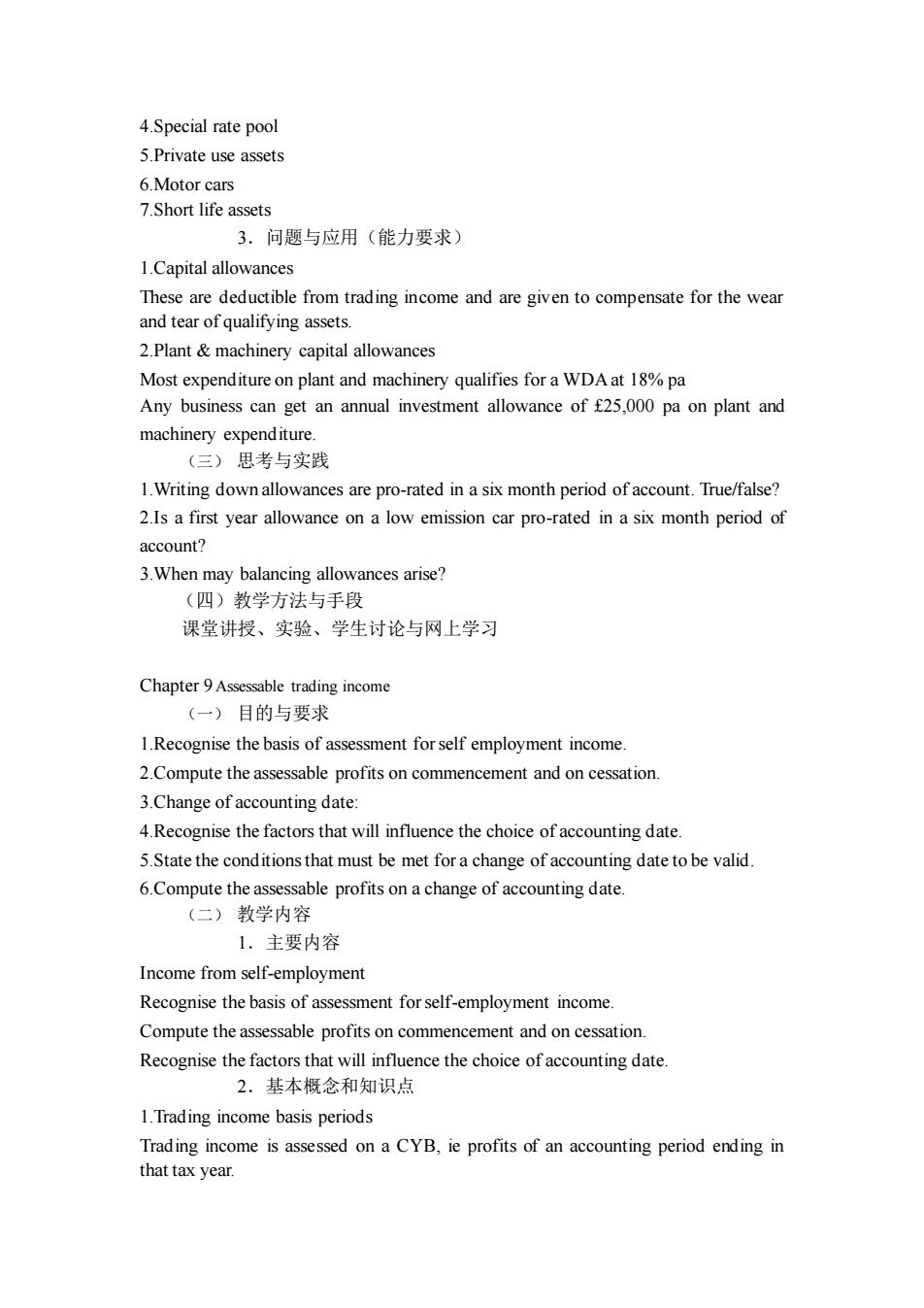
3.问题与应用(能力要求) 1.The benefits oftrade 2.The adjustment of profits 3.Cash basis of accounting for small businesses 4.Pre-trading expenditure (三)思考与实践 1.What are the remoteness test and the duality test? 2.No adjustment for taxation is required to the accounts for deduction of a trader's salary.True/False? 3.Which business can use the cash basis of accounting? (四)教学方法与手段 课堂讲授、实验、学生讨论与网上学习 Chapter8 Capital allowance (一)目的与要求 1.Define plant and machinery for capital allowances purposes. 2.Compute writing down allowances.first year allowances and annual investment allowance 3.Compute capital allowances for motor cars. 4.Compute balancing allowances and balancing charges. 5.Recognise the treatment of short life assets. 6.Explain the treatment of assets included in the special rate pool. (一)教学内容 1.主要内容 Income from self-employment Capital allowances. Define plant and machinery for capital allowances purposes. Compute writing down allowances,first year allowances and the annual investment allowance Compute capital allowances for motor cars Compute balancing allowance and balancing charges Recognise the treatment of short life assets Recognise the treatment of assets included in the special rate pool 2.基本概念和知识点 1.Capital allowances in general 2.Plant and machinery-qualifying expenditure 3.The main pool
3.Pre trading expenditure 3.问题与应用(能力要求) 1.The benefits of trade 2.The adjustment of profits 3.Cash basis of accounting for small businesses 4.Pre-trading expenditure (三) 思考与实践 1.What are the remoteness test and the duality test? 2.No adjustment for taxation is required to the accounts for deduction of a trader’s salary.True/False? 3.Which business can use the cash basis of accounting? (四)教学方法与手段 课堂讲授、实验、学生讨论与网上学习 Chapter 8 Capital allowance (一) 目的与要求 1.Define plant and machinery for capital allowances purposes. 2.Compute writing down allowances, first year allowances and annual investment allowance. 3.Compute capital allowances for motor cars. 4.Compute balancing allowances and balancing charges. 5.Recognise the treatment of short life assets. 6.Explain the treatment of assets included in the special rate pool. (二) 教学内容 1.主要内容 Income from self-employment Capital allowances. Define plant and machinery for capital allowances purposes. Compute writing down allowances,first year allowances and the annual investment allowance. Compute capital allowances for motor cars. Compute balancing allowance and balancing charges. Recognise the treatment of short life assets. Recognise the treatment of assets included in the special rate pool. 2.基本概念和知识点 1.Capital allowances in general 2.Plant and machinery-qualifying expenditure 3.The main pool

4.Special rate pool 5.Private use assets 6.Motor cars 7.Short life assets 3.问题与应用(能力要求) 1.Capital allowances These are deductible from trading income and are given to compensate for the wear and tear of qualifying assets. 2.Plant&machinery capital allowances Most expenditure on plant and machinery qualifies for a WDA at 18%pa Any business can get an annual investment allowance of f25.000 pa on plant and machinery expenditure. (三)思考与实践 1.Writing down allowances are pro-rated in a six month period of account.True/false? 2.Is a first year allowance on a low emission car pro-rated in a six month period of account? 3.When may balancing allowances arise? (四)教学方法与手段 课堂讲授、实验、学生讨论与网上学习 Chapter 9Assessable trading income (一)目的与要求 1.Recognise the basis of assessment for self employment income. 2.Compute the assessable profits on commencement and on cessation 3.Change of accounting date: 4.Recognise the factors that will influence the choice of accounting date. 5.State the conditions that must be met for a change of accounting date to be valid 6.Compute the assessable profits on a change of accounting date. (一)教学内容 1,主要内容 Income from self-employment Recognise the basis of assessment for self-employment income. Compute the assessable profits on commencement and on cessation. Recognise the factors that will influence the choice of accounting date 2.基本概念和知识点 1.Trading income basis periods Trading income is assessed on a CYB,ie profits of an accounting period ending in that tax year
4.Special rate pool 5.Private use assets 6.Motor cars 7.Short life assets 3.问题与应用(能力要求) 1.Capital allowances These are deductible from trading income and are given to compensate for the wear and tear of qualifying assets. 2.Plant & machinery capital allowances Most expenditure on plant and machinery qualifies for a WDA at 18% pa Any business can get an annual investment allowance of £25,000 pa on plant and machinery expenditure. (三) 思考与实践 1.Writing down allowances are pro-rated in a six month period of account. True/false? 2.Is a first year allowance on a low emission car pro-rated in a six month period of account? 3.When may balancing allowances arise? (四)教学方法与手段 课堂讲授、实验、学生讨论与网上学习 Chapter 9 Assessable trading income (一) 目的与要求 1.Recognise the basis of assessment for self employment income. 2.Compute the assessable profits on commencement and on cessation. 3.Change of accounting date: 4.Recognise the factors that will influence the choice of accounting date. 5.State the conditions that must be met for a change of accounting date to be valid. 6.Compute the assessable profits on a change of accounting date. (二) 教学内容 1.主要内容 Income from self-employment Recognise the basis of assessment for self-employment income. Compute the assessable profits on commencement and on cessation. Recognise the factors that will influence the choice of accounting date. 2.基本概念和知识点 1.Trading income basis periods Trading income is assessed on a CYB, ie profits of an accounting period ending in that tax year